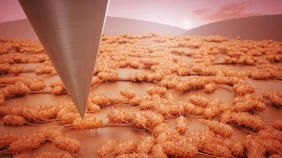Home > Press > New imaging approach transforms study of bacterial biofilms
 |
| This artistic rendering depicts an atomic force microscopy tip scanning a structured network of bacterial cells with flagella in a honeycomb pattern. High-resolution surface characterization spans a wide field of view.
Credit Adam Malin/ORNL, U.S. Dept. of Energy |
Abstract:
Scientists at the Department of Energys Oak Ridge National Laboratory have reimagined the capabilities of atomic force microscopy, or AFM, transforming it from a tool for imaging nanoscale features into one that also captures large-scale biological architecture. Often called a touching microscope, AFM uses a fine probe to feel surfaces at resolutions down to a billionth of a meter. Although powerful, traditional AFM has been limited by its narrow field of view, making it difficult to understand how individual features fit into larger organizational structures.
New imaging approach transforms study of bacterial biofilms
Oak Ridge, TN | Posted on August 8th, 2025
Researchers at the Center for Nanophase Materials Sciences, a DOE Office of Science user facility at ORNL, have now overcome this limitation by developing an automated large-area AFM platform. Demonstrated on bacterial biofilms resilient microbial communities that grow on a range of surfaces the system connects detailed observations at the level of individual parts with broader views that cover larger areas. This advance offers an unprecedented view of biofilm organization, with innovations for medicine, industry and environmental science.
Biofilms can cause infections, clog pipes, damage equipment and disrupt ecosystems, so they have broad impact. Understanding how biofilms form and organize on surfaces can lead to better infection treatments, more effective cleaning and maintenance strategies, and improved management of natural ecosystems and water quality. Biofilms begin when individual bacteria use sticky proteins or appendages to anchor themselves to a surface. These so-called pioneer cells then grow and recruit others, forming complex, hard-to-remove communities.
In biofilm research, weve often been able to see the trees, but not the forest, said Ruben Millan-Solsona, a postdoctoral researcher in ORNLs Functional Atomic Force Microscopy group and the studys co-leader. Using the AFM, we could examine individual bacterial cells in detail but not how they organize and interact as communities. Liam Collins, an R&D researcher in ORNL’s Functional Atomic Force Microscopy group and the studys co-leader, added, This new platform changes that. Now, we can visualize both the intricate structures of single cells and the larger patterns across entire biofilms.
A key innovation lies in integrating machine learning with the imaging process. The large-area AFM provides researchers with large-scale, high-resolution views of biofilms, said Sita Sirisha Madugula, a postdoctoral researcher in ORNLs Data Nanoanalytics group and co-author of the study. The integration of machine learning allows us to extract meaningful quantitative data from these massive datasets. The team automatically analyzed more than 19,000 individual cells to generate detailed maps of cell properties across extensive surface areas, revealing that bacteria align in honeycomb-like patterns, interconnected by flagella hair-like appendages that may help with initial attachment and growth.
Though the biological role of these patterns is still under investigation, they likely play a part in strengthening biofilm cohesion and adaptability, Collins said.
To further probe biofilm dynamics, the team tested engineered surfaces with nanoscale ridges features thousands of times thinner than a human hair. They found that specific patterns could disrupt normal biofilm formation, offering potential strategies for designing antifouling surfaces that resist bacterial buildup.
Published in npj Biofilms and Microbiomes, the research marks a significant leap forward in biofilm science. It is supported by the DOE Office of Science through the Biopreparedness Research Virtual Environment, or BRaVe, initiative, which explores interactions between living systems and materials.
This collaboration shows whats possible when scientists from different disciplines come together, said Scott Retterer, CNMS director and principal investigator for BRaVE. The advanced tools were developing are essential for understanding how organisms interact with materials a key step to identifying surface properties that resist biofilm formation, which has important applications from healthcare to food safety.
The work also benefited from partnerships with the Bredesen Center for Interdisciplinary Research and the University of Tennessee-Oak Ridge Innovation Institute, which contributed to refining the computational algorithms used in the study.
####
About DOE/Oak Ridge National Laboratory
UT-Battelle manages ORNL for DOEs Office of Science, the single largest supporter of basic research in the physical sciences in the United States. DOEs Office of Science is working to address some of the most pressing challenges of our time. For more information, visit energy.gov/science. Scott Gibson
For more information, please click here
Contacts:
Scott Gibson
DOE/Oak Ridge National Laboratory
Cell: 8652066499
Copyright © DOE/Oak Ridge National Laboratory
If you have a comment, please Contact us.
Issuers of news releases, not 7th Wave, Inc. or Nanotechnology Now, are solely responsible for the accuracy of the content.
News and information
![]()
Lab to industry: InSe wafer-scale breakthrough for future electronics August 8th, 2025
![]()
Ben-Gurion University of the Negev researchers several steps closer to harnessing patient’s own T-cells to fight off cancer June 6th, 2025
![]()
Researchers unveil a groundbreaking clay-based solution to capture carbon dioxide and combat climate change June 6th, 2025
![]()
Self-propelled protein-based nanomotors for enhanced cancer therapy by inducing ferroptosis June 6th, 2025
Imaging
![]()
Turning up the signal November 8th, 2024
![]()
New discovery aims to improve the design of microelectronic devices September 13th, 2024
![]()
Quantum researchers cause controlled wobble in the nucleus of a single atom September 13th, 2024
Govt.-Legislation/Regulation/Funding/Policy
![]()
Electrifying results shed light on graphene foam as a potential material for lab grown cartilage June 6th, 2025
![]()
Institute for Nanoscience hosts annual proposal planning meeting May 16th, 2025
![]()
Rice researchers harness gravity to create low-cost device for rapid cell analysis February 28th, 2025
Possible Futures
![]()
Lab to industry: InSe wafer-scale breakthrough for future electronics August 8th, 2025
![]()
Quantum computers simulate fundamental physics: shedding light on the building blocks of nature June 6th, 2025
![]()
A 1960s idea inspires NBI researchers to study hitherto inaccessible quantum states June 6th, 2025
![]()
Self-propelled protein-based nanomotors for enhanced cancer therapy by inducing ferroptosis June 6th, 2025
Nanomedicine
![]()
Ben-Gurion University of the Negev researchers several steps closer to harnessing patient’s own T-cells to fight off cancer June 6th, 2025
![]()
Cambridge chemists discover simple way to build bigger molecules one carbon at a time June 6th, 2025
![]()
Electrifying results shed light on graphene foam as a potential material for lab grown cartilage June 6th, 2025
![]()
Self-propelled protein-based nanomotors for enhanced cancer therapy by inducing ferroptosis June 6th, 2025
Discoveries
![]()
Electrifying results shed light on graphene foam as a potential material for lab grown cartilage June 6th, 2025
![]()
Quantum computers simulate fundamental physics: shedding light on the building blocks of nature June 6th, 2025
![]()
A 1960s idea inspires NBI researchers to study hitherto inaccessible quantum states June 6th, 2025
![]()
Self-propelled protein-based nanomotors for enhanced cancer therapy by inducing ferroptosis June 6th, 2025
Announcements
![]()
Lab to industry: InSe wafer-scale breakthrough for future electronics August 8th, 2025
![]()
Cambridge chemists discover simple way to build bigger molecules one carbon at a time June 6th, 2025
![]()
Electrifying results shed light on graphene foam as a potential material for lab grown cartilage June 6th, 2025
Interviews/Book Reviews/Essays/Reports/Podcasts/Journals/White papers/Posters
![]()
Lab to industry: InSe wafer-scale breakthrough for future electronics August 8th, 2025
![]()
Quantum computers simulate fundamental physics: shedding light on the building blocks of nature June 6th, 2025
![]()
A 1960s idea inspires NBI researchers to study hitherto inaccessible quantum states June 6th, 2025
![]()
Self-propelled protein-based nanomotors for enhanced cancer therapy by inducing ferroptosis June 6th, 2025
Food/Agriculture/Supplements
![]()
SMART researchers pioneer first-of-its-kind nanosensor for real-time iron detection in plants February 28th, 2025
![]()
Silver nanoparticles: guaranteeing antimicrobial safe-tea November 17th, 2023
![]()
Night-time radiative warming using the atmosphere November 17th, 2023
Nanobiotechnology
![]()
Ben-Gurion University of the Negev researchers several steps closer to harnessing patient’s own T-cells to fight off cancer June 6th, 2025
![]()
Electrifying results shed light on graphene foam as a potential material for lab grown cartilage June 6th, 2025
![]()
Self-propelled protein-based nanomotors for enhanced cancer therapy by inducing ferroptosis June 6th, 2025










